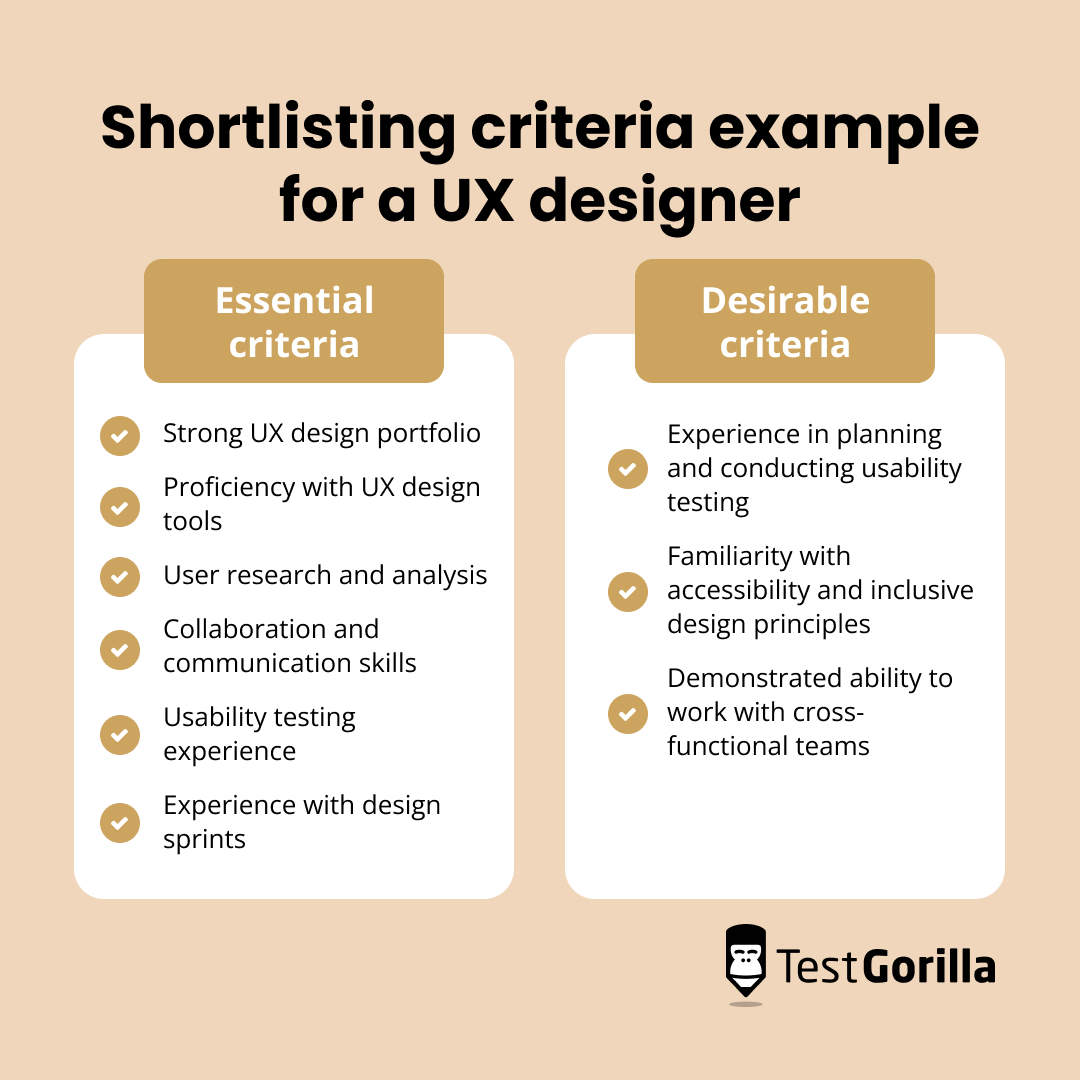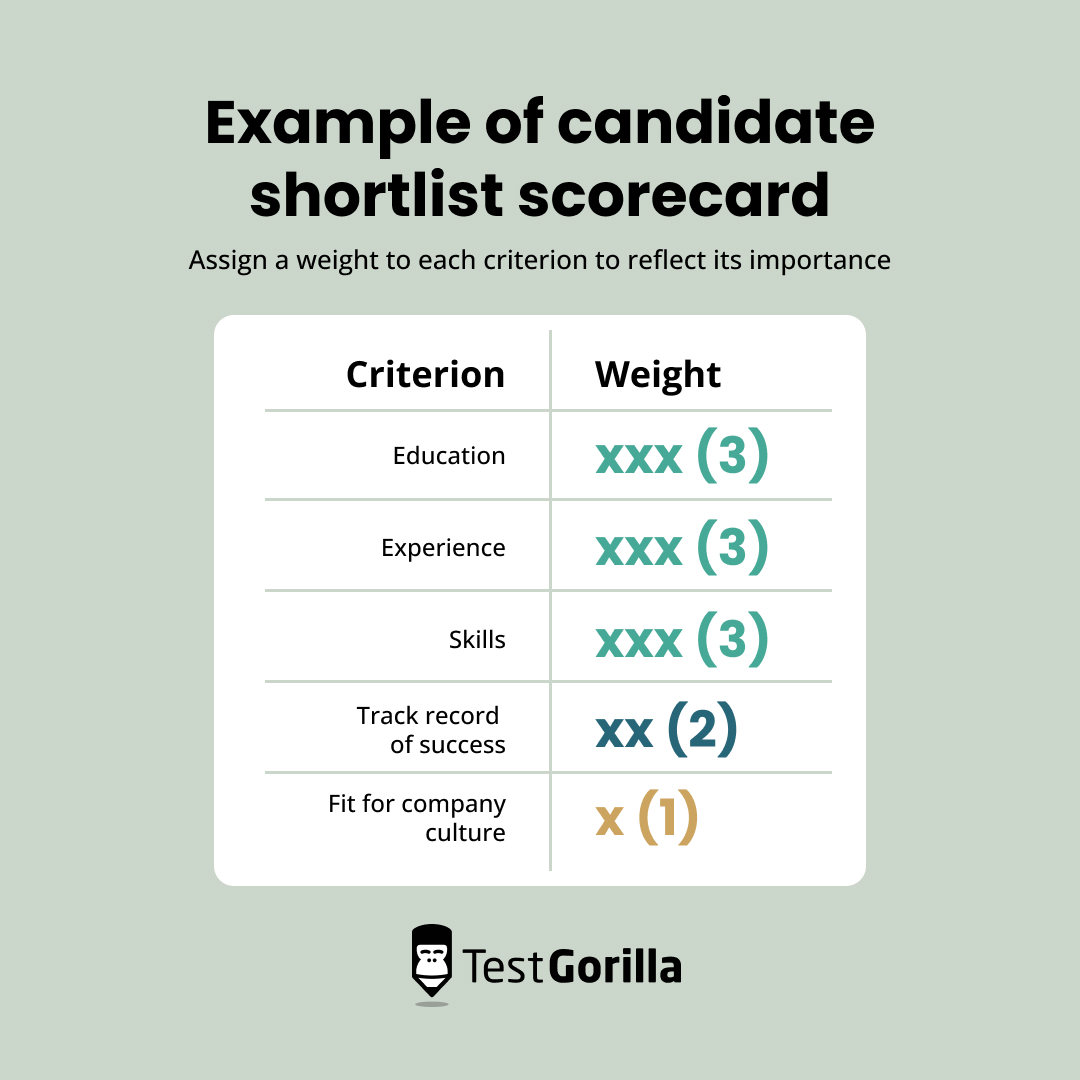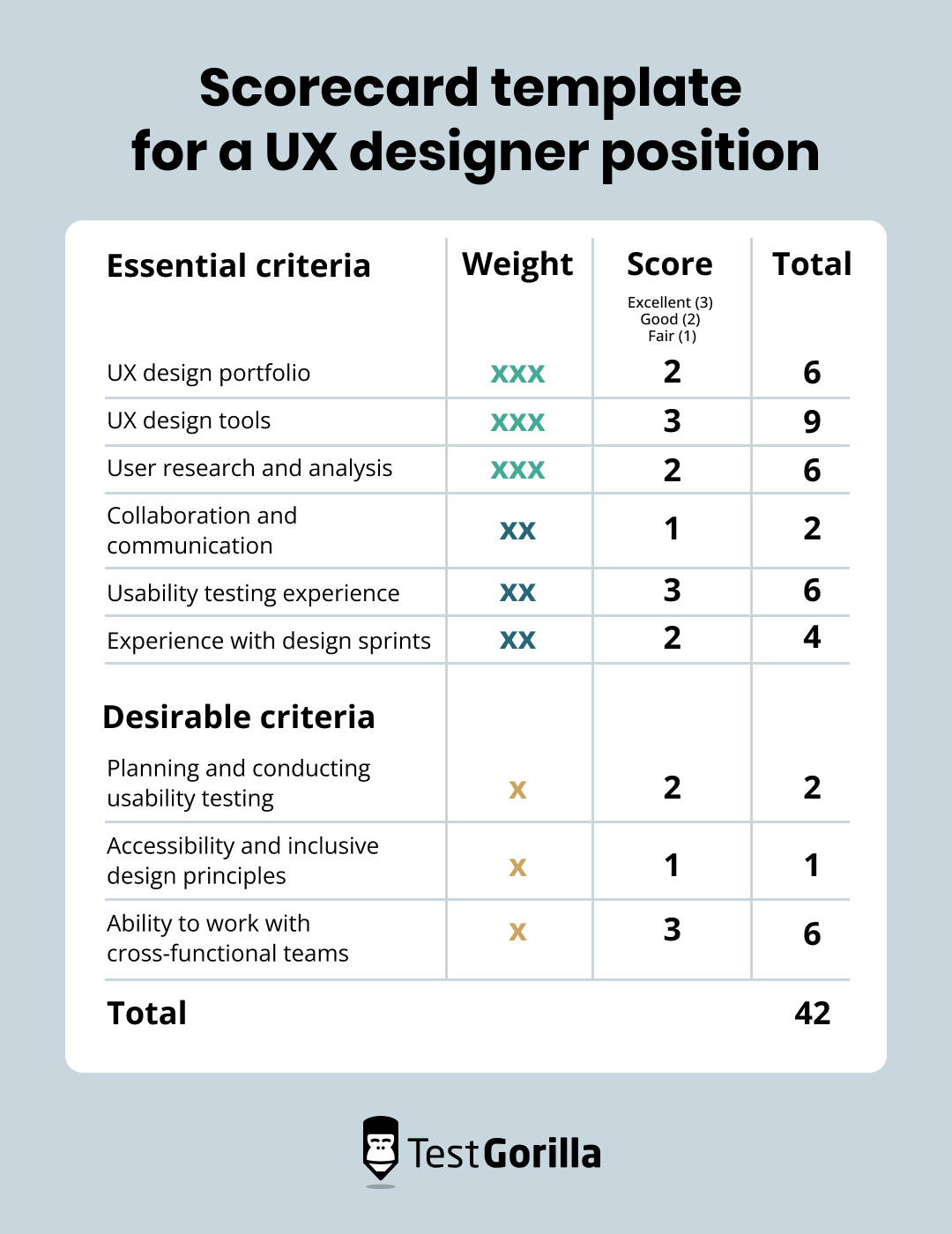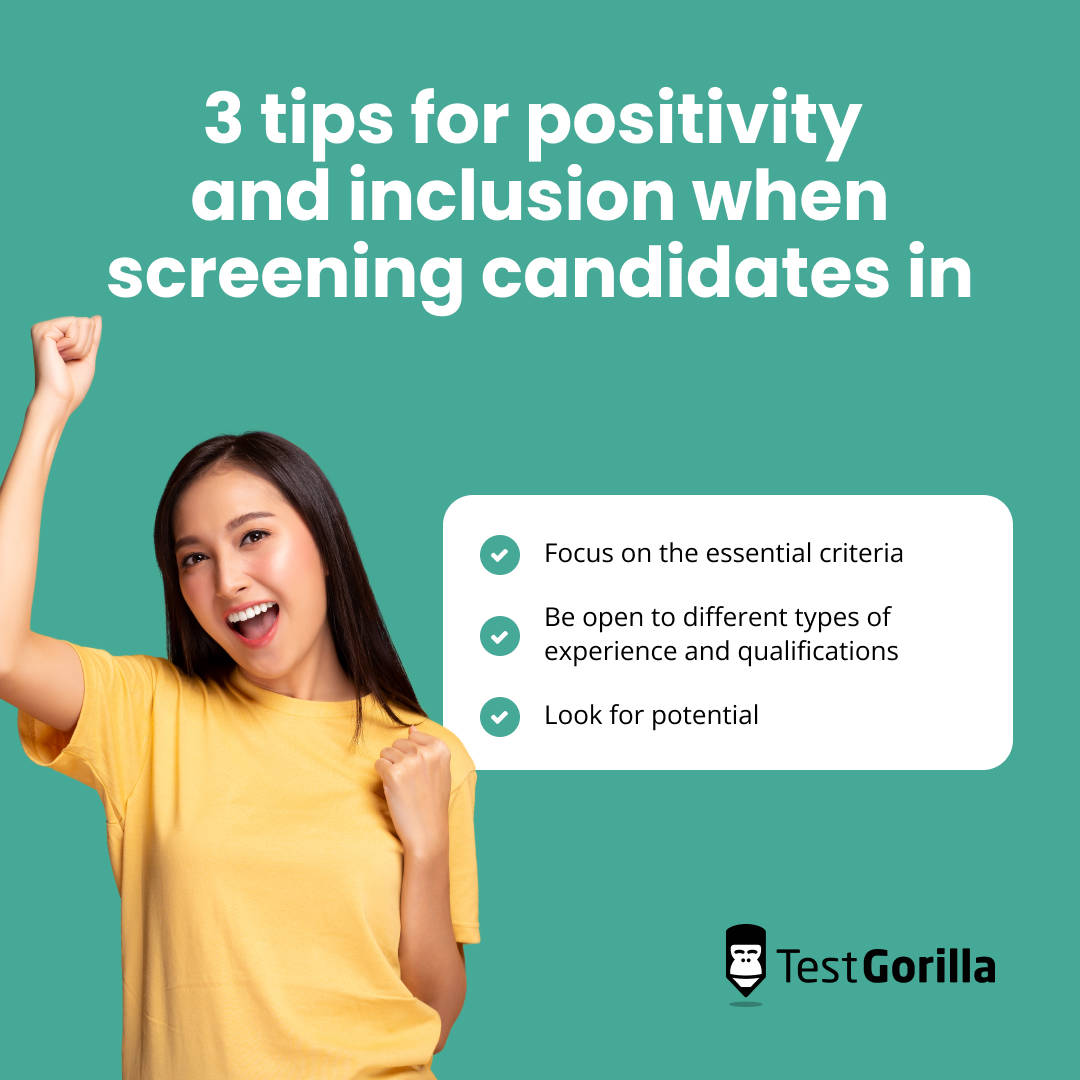Simplify candidate shortlisting in 7 steps (with scorecard and examples)
Does this scenario look familiar to you?
After posting your job listing last week, you have now over 500 applications in your inbox. This is a great response but this also means that you have a lot of work to do. Your next step is to shortlist the best candidates for an interview.
Now, where exactly do you start with your candidate shortlisting process? And how can you make sure that you're making fair and unbiased hiring decisions?
This guide will help make your shortlisting process as objective and bias-free as possible.
Let's take a closer look at how you can simplify the shortlisting process to find the right candidates plus an example of a shortlisting criteria scorecard that you can use.
What is shortlisting in recruitment?
Shortlisting candidates in the recruitment process involves coming up with a list of shortlisted candidates that you want to invite to the next step of your hiring process (in most cases, that’s some form of an interview).
A shortlist is usually based on specific criteria you set before you share your job posting. Then, based on how well each candidate meets that criteria, you’ll determine who qualifies to go to the next step of your recruiting process.
Shortlisting candidates takes what can be an overwhelming process and makes it more manageable by removing unqualified candidates right off the bat. Instead of poring over hundreds of applications to get to the select few who might be a fit, you can focus on the best available talent from the start.
How to shortlist candidates like a pro: A 7-step guide
There’s a right and wrong way to shortlist candidates. The wrong way will lead to mis-hires and possibly open you up to lawsuits (which we will discuss in more detail below). The right way will make your hiring process more efficient and help you find the best person for the job.
Here's how a good candidate shortlist process looks like.
Step 1: Define and develop your shortlisting criteria.
Your first step is to define a set of criteria that encapsulates both essential and desirable qualifications and traits for the role.
There are a few reasons why it's important to determine the criteria you're looking for in advance. First, you'll want to include it in the job description. This allows applicants to highlight them in their resume, which will ultimately make your job easier.
Second, by developing the criteria in advance, you can ensure that you don't lose sight of what you were initially looking for in the role as you start looking at the available candidates. Sometimes, you'll find yourself charmed by a candidate and overvaluing the qualifications they do have, even if they don't outweigh the qualifications they don't have. Or, if you're struggling to find the right fit, you might convince yourself to settle for someone who won't be able to perform the duties of the job.
Finally, having your shortlisting criteria before posting the job will reduce the probability that bias or discrimination will creep into your hiring process. By using criteria that correlate with job performance and the needs of the specific role you're looking to fill, you'll be less likely to be accused of discriminating against a qualified individual based on factors that are prohibited by law. If you do find that your organization is the target of legal action, you'll be able to point to the process you have in place to guard against employment discrimination.
Some factors to consider when setting your criteria are:
Education level
Skills and knowledge
Work experience
One final thing to remember: it's important not to set criteria that are so strict that they will dissuade quality candidates from applying, and not so open that they will attract a large applicant pool filled with qualified candidates. You have to strike the right balance.
And be realistic about your expectations. It would be nice to have someone who's a ten out of ten on every metric, but depending on the compensation, location, and other factors, that might not be possible.
For example, if you're going to be paying a salary that's in line with what entry-level employees receive, it's unlikely that you'll be able to persuade someone with senior-level experience to accept the offer you can afford to make. If you ignore that consideration, you'll probably come to find that you've rejected a lot of good candidates who would have been excited to take on the role. Then, when your selected unicorn candidate rejects your offer, you're up a creek without a paddle.
Understanding the difference between essential and desirable criteria
When you're deciding what you're looking for in an ideal candidate, you'll typically have two types of traits, skills, or experience you'll be looking for: essential and desirable criteria. They're also referred to as "required" and "preferred," but whatever you call them, it's important to know where each of your shortlisting criteria fits.
Essential criteria
These are must have skills for a candidate to be qualified for the role. An example of an essential criterion is whether or not an applicant is legally allowed to work in the country. Or if you're hiring for a Salesforce administrator, Salesforce certification may be required.
Desirable criteria
These are secondary requirements or "nice-to-haves" that may give an applicant an edge over other candidates. If you have a wealth of qualified candidates and you're looking for a way to narrow down the list of candidates who will move forward, these qualifications can help.
For example, you might have a lot of great Salesforce certified applicants, but a few of them are certified in Marketo as well. If Marketo certification is one of your preferred criteria, then this can help you decide which candidates to invite to the next round of the hiring process.
It's worth noting that desirable criteria can sometimes become de facto essential criteria. For example, if a recruiter listed a minimum of five years of experience in a certain role as one of the desirable criteria, and most of the applicants turn out to meet this qualification, the recruiter may decide that this is now essential. This means that all the other applicants who do not have at least five years of experience will be screened out.
Shortlisting criteria examples
Here are two examples of shortlisting criteria which include both essential and desirable characteristics.
Shortlisting criteria example for a warehouse supervisor
Essential criteria
Previous warehouse management experience (3 years minimum)
Knowledge of inventory management
Safety and compliance awareness
Leadership and team management
Problem-solving and decision-making skills
Desirable criteria
Experience in training and performance evaluations
Familiarity with specific inventory management software
Certifications in warehouse management or safety
Shortlisting criteria example for a UX designer
Essential criteria
Strong UX design portfolio
Proficiency with UX design tools
User research and analysis
Collaboration and communication skills
Usability testing experience
Experience with design sprints
Desirable criteria
Experience in planning and conducting usability testing
Familiarity with accessibility and inclusive design principles
Demonstrated ability to work with cross-functional teams.
TestGorilla's skills assessment tests help to screen candidates, such as the UX/UI Design test for this example.
Step 2: Develop a candidate scorecard.
A candidate shortlist scorecard can help you assess candidates objectively and consistently. The scorecard should be based on your shortlist criteria, and each candidate is given a score for each criterion. The candidates with the highest scores are then shortlisted for interviews.
Here are some of the benefits of using a candidate shortlist scorecard:
Objectivity: The scorecard helps to ensure that candidates are assessed objectively and consistently. This reduces the risk of bias and discrimination in the shortlisting process.
Transparency: The scorecard can be used to communicate the shortlisting criteria to candidates and to provide feedback to candidates who are not shortlisted. This helps to make the shortlisting process more transparent and fair.
Efficiency: The scorecard can streamline the shortlisting process by making it easier to compare candidates and to identify the candidates who best meet the criteria for the role.
To create a candidate shortlist scorecard, you should first identify the essential and desirable criteria for the role. You can then assign a weight to each criterion to reflect its importance. For example, you might give essential criteria a weight of 3 and desirable criteria a weight of 2.
Once you have assigned weights to the criteria, you can create a scorecard that lists the criteria and the corresponding weights. Take a look at the example below.
You can then score each candidate for each criterion. For example, you might give a candidate a score of 3 for education if they have the required degree and experience, a score of 2 for experience if they have some experience in the relevant field, and a score of 1 for skills if they have some of the required skills.
Once you have scored each candidate for each criterion, you can calculate their total score by multiplying each score by the corresponding weight and then adding the results together. The candidates who scored high in your screening process are then shortlisted for interviews.
The example below is a scorecard template for a UX designer position.
Pro tip: If your criteria are mostly skills-based, certain online skills assessment platforms will negate the need for a scorecard. For instance, in TestGorilla, every candidate is automatically scored in the platform so all you have to do is sort them based on their test results.
Step 3: Decide on the number of candidates you're including in your shortlist.
A shortlist should be short. When it comes to how many candidates you should include or the maximum number of applicants to be shortlisted, most hiring managers have a predetermined number. For example, if they need to hire one candidate, in most cases, only four or five applicants will make it to the interview stage.
For high-volume recruitment, where more people are needed, you might shortlist any applicant who meets the essential criteria.
A good rule of thumb is to shortlist no more than 10-12 candidates for an interview.
Step 4: Review applications and screen for qualified candidates using your scorecard.
The next step is to screen the resumes of all applicants to identify the candidates who meet the essential criteria for the role. You can use an applicant tracking system (ATS) to automate this process, or you can do it manually.
When screening resumes, look for candidates with the required education, experience, and skills. You should also look for candidates who have a strong track record of success and who are a good culture add to your organization.
Screen candidates in instead of screening them out.
Screening candidates in means looking for reasons why a candidate might be a good fit for the role, rather than looking for reasons to exclude them. This is a more positive and inclusive approach to screening, and it can help you to identify a wider range of qualified candidates.
Here are some tips for screening candidates in:
Focus on the essential criteria. Make sure that you have clearly defined the essential criteria for the role,and focus on screening candidates who meet those criteria.
Be open to different types of experience and qualifications. Don't limit yourself to candidates who have the exact same experience and qualifications as your ideal candidate. Be open to considering candidates with different backgrounds and skills, as they may bring a new perspective to the role.
Look for potential. When screening candidates, consider their potential to grow and develop in the role. Don't just focus on their current skills and experience.
On the other hand, screening candidates out means looking for reasons why a candidate might not be a good fit for the role. This can be a necessary step in the screening process, but it is important to be mindful of the potential for bias and discrimination.
Quick note on blind applicant screening
Blind applicant screening is a process of screening resumes without any identifying information about the candidate, such as their name, gender, and ethnicity. This can help reduce bias in the shortlisting process.
To implement blind hiring, you can remove all identifying information from resumes before you start screening. You can also use an ATS that supports blind screening.
Step 5: Use skills assessments to measure specific skills
If you need to assess specific skills for the role, you can use online skills assessments during the shortlisting process.
Skill assessment tests offer a formal, scientific, and standardized method for evaluating the skills of job candidates so you can objectively define, measure, and evaluate candidates’ abilities and qualifications, and then rank candidates based on their scores.
TestGorilla has 300+ candidate-friendly skills and personality tests for fast and accurate pre-employment screening.
Step 6: Review your shortlist and make selections
Once you have completed the shortlisting process, you should review your shortlist and make selections for interviews.
It's also important to consider the diversity of your shortlist. Make sure to select candidates from a variety of backgrounds and with a variety of skills and experience.
Step 7: Let candidates who didn't make it to the shortlist know.
Once you have shortlisted candidates, it is important to let the other candidates who applied know they were not selected for the interview. This is a courtesy to the candidates and it shows that you respect their time and effort.
You can let candidates know that they were not shortlisted by email or by phone. If you are emailing candidates, be sure to personalize the email and thank them for their interest in the role. You can also provide them with some feedback, such as the skills and experience that you were looking for in a candidate.
Here is an example of a short email that you can use to let candidates know that they were not shortlisted:
Dear [Candidate Name],
Thank you for your interest in the UX Designer position at [Company Name]. We appreciate you taking the time to apply for the role and to submit your resume and portfolio.
After careful consideration, we have decided to move forward with other candidates whose skills and experience more closely align with the requirements of the role.
We wish you the best of luck in your job search.
Sincerely,
[Your Name]
The best insights on HR and recruitment, delivered to your inbox.
Biweekly updates. No spam. Unsubscribe any time.
What are the legal implications of shortlisting candidates
Shortlisting candidates in the recruitment process has legal implications that organizations must be aware of to avoid potential legal issues. These implications may vary by country and region, but some common legal considerations include:
Discrimination
It is illegal to discriminate against any candidate on the basis of their protected characteristics, such as race, gender, age, disability, and sexual orientation. This means that hiring managers and recruiters cannot exclude candidates from the shortlisting process because of their protected characteristics.
Fairness
The shortlisting process must be fair and transparent. Hiring managers and recruiters must apply the same criteria to all candidates and must not make decisions based on personal bias or prejudice.
Data protection
Hiring managers and recruiters must comply with all relevant data protection laws and regulations when collecting and processing candidate data. This includes obtaining consent from candidates to collect and use their data and ensuring that their data is securely stored and processed.
Further reading: A guide to the GDPR for employers
Here are some tips for avoiding legal pitfalls when shortlisting candidates:
Develop clear and objective shortlisting criteria that are relevant to the role.
Apply the shortlisting criteria consistently to all candidates.
Do not exclude candidates from the shortlisting process based on their protected characteristics.
Be transparent about the shortlisting process and provide feedback to candidates who are not shortlisted.
Obtain consent from candidates to collect and use their data and ensure that their data is securely stored and processed.
If you are unsure about any legal aspects of the shortlisting process, it is always best to seek professional advice.
Simplify your shortlisting process with skills testing and make better hires
An effective shortlisting process will also improve your overall hiring performance. After you optimize your shortlisting approach, you should find that you’re making better hires faster—not to mention saving yourself a lot of headaches!
Thanks to online skills assessment tools like TestGorilla, you can quickly identify the best-qualified candidates to interview in a matter of minutes so that you can complete the hiring process before your top candidate accepts an offer from a competitor.
Take a product tour with TestGorilla today. Or you can sign up for an account right away.
Related posts
You've scrolled this far
Why not try TestGorilla for free, and see what happens when you put skills first.


















